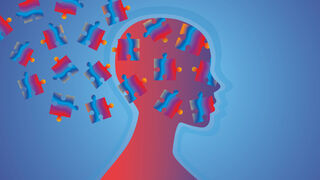Identity
The Importance of Not Being Who You Think You Are
Recent research suggests that ego dissolution can protect you from illnesses.
Posted October 22, 2022 Reviewed by Abigail Fagan
Key points
- Ego dissolution may protect you psychologically and physically.
- Psychedelics, transcendental meditation (TM), and virtual reality (VR) all assist with ego dissolution.
- When the self-circuit in the brain is reconstituted by psychedelics, TM or VR, inflammation may decrease, and well-being may be enhanced.

During adolescence, you may discover new parts of your identity and change who you think you are1, but most adults eventually settle into a more stable way of being. On the one hand, the idea of stability is reassuring. The brain is not particularly fond of change2. Yet, this stability may lead to a more “frozen” identity that limits your capabilities and life.
In September 2022, psychiatrist Lawrence Fischman explained that therapists notice that when people use psychedelics under supervision, they develop new beliefs about themselves and the world3. They have a more intense feeling of knowing and being known. The brain activity usually constrained in normal waking consciousness—to manage the complexity of interactions of the 100 billion neurons and 100 trillion connections—suddenly changes. And psychedelics challenge the status quo by inducing a state of brain entropy (disorder) during which users experience a transient shift in how they see themselves and the rest of the world4. Commonly, people return to normal waking consciousness with a renewed understanding of who they are.
“Who you are” is synonymous with the “ego”—the sense that your identity is fixed, integrated, and immutable. Yet, as psychedelic research indicates, your identity is likely far less fixed than you may believe. Indeed, interrogating this fixedness may yield many psychological and physical benefits.
The psychological benefits of ego dissolution
The thought of dissolving your ego may be petrifying due to the very real threat of psychosis5. Still,there are situations in which ego-dissolution leads to a transcendent state in which you feel a greater state of connectedness, and you unlock yourself from a world of fixed probabilities to one of possibilities6.
This freedom to be someone else—to be someone other than who you thought you were—can be very healing indeed. Studies indicate that psychedelics may relieve anxiety7 and depression and enhance an overall sense of emotional wellbeing8. In addition, other ego-dissolving methods such as transcendental meditation (TM) may decrease anxiety and stress9, and group virtual reality (VR) experiences are similar to psychedelics in leading to ego-dissolution10allowing people to feel more connected to one another. Indeed, in VR, when an illusory self takes on a primary experience of the virtual world, the self is divided into your actual self, and the one in VR, and the calming of the illusory self can transfer to your actual self too 11.
The physical benefits of ego-dissolution
In the brain, the self is represented by the default mode network (DMN)12. This network is affected by inflammation, which underlies many disease states13 such as cardiovascular disease, cancer, diabetes mellitus, chronic kidney disease, non-alcoholic fatty liver disease and autoimmune and neurodegenerative disorders. Recent research indicates that the DMN can be disrupted or impacted by psychedelics4,14, TM15,16 and VR17. As a result, I hypothesize that when the network that represents the self is disrupted, inflammatory processes may be interrupted by ego-dissolving methodologies.
Indeed, psychedelics have been identified as potential anti-inflammatory agents18,19. Long-term meditators who practice TM can downregulate (turn off) 49 genes associated with inflammation20. And VR has been shown to significantly reduce pain intensity21 and inflammation as well22.
Putting this all together
When you fix “who you are”, you may be freezing the activity in the DMN, thereby starting a cascade of inflammation that leads to physical and psychological distress and illness. Ego-dissolving modalities (such as psychedelics, TM, and VR) can “unfreeze” who you are, allowing you to reconstitute yourself. As a result, this decreases the body’s inflammatory response to your frozen identity and the associated diseases and discomfort that come with it.
If you feel anxious, sad, inflamed, or sick, consider that you may have invested too much of your identity in an unchanging way of being. Take a step back from who you think you are and consider exploring another version of yourself for your well-being.
References
1. Branje S, de Moor EL, Spitzer J, Becht AI. Dynamics of Identity Development in Adolescence: A Decade in Review. J Res Adolesc. 2021;31(4):908-927. doi:10.1111/jora.12678
2. Colosio M, Shestakova A, Nikulin VV, Blagovechtchenski E, Klucharev V. Neural Mechanisms of Cognitive Dissonance (Revised): An EEG Study. J Neurosci. 2017;37(20):5074-5083. doi:10.1523/JNEUROSCI.3209-16.2017
3. Fischman LG. Knowing and being known: Psychedelic–assisted psychotherapy and the sense of authenticity. Front Psychiatry. 2022;13:933495. doi:10.3389/fpsyt.2022.933495
4. Carhart-Harris RL, Leech R, Hellyer PJ, et al. The entropic brain: a theory of conscious states informed by neuroimaging research with psychedelic drugs. Front Hum Neurosci. 2014;8. doi:10.3389/fnhum.2014.00020
5. Mitterauer B. The loss of ego boundaries in schizophrenia: a neuromolecular hypothesis. Med Hypotheses. 2001;56(5):614-621. doi:10.1054/mehy.2000.1181
6. Stoliker D, Egan GF, Friston KJ, Razi A. Neural Mechanisms and Psychology of Psychedelic Ego Dissolution. Barker E, ed. Pharmacol Rev. 2022;74(4):876-917. doi:10.1124/pharmrev.121.000508
7. Weston NM, Gibbs D, Bird CIV, et al. Historic psychedelic drug trials and the treatment of anxiety disorders. Depress Anxiety. 2020;37(12):1261-1279. doi:10.1002/da.23065
8. Raison CL, Jain R, Penn AD, Cole SP, Jain S. Effects of Naturalistic Psychedelic Use on Depression, Anxiety, and Well-Being: Associations With Patterns of Use, Reported Harms, and Transformative Mental States. Front Psychiatry. 2022;13:831092. doi:10.3389/fpsyt.2022.831092
9. Church D, Yang A, Fannin J, Blickheuser K. The biological dimensions of transcendent states: A randomized controlled trial. Front Psychol. 2022;13:928123. doi:10.3389/fpsyg.2022.928123
10. Glowacki DR, Williams RR, Wonnacott MD, et al. Group VR experiences can produce ego attenuation and connectedness comparable to psychedelics. Sci Rep. 2022;12(1):8995. doi:10.1038/s41598-022-12637-z
11. Kalantari S, Bill Xu T, Mostafavi A, et al. Using a Nature-Based Virtual Reality Environment for Improving Mood States and Cognitive Engagement in Older Adults: A Mixed-Method Feasibility Study. Innov Aging. 2022;6(3):igac015. doi:10.1093/geroni/igac015
12. Davey CG, Harrison BJ. The brain’s center of gravity: how the default mode network helps us to understand the self. World Psychiatry. 2018;17(3):278-279. doi:10.1002/wps.20553
13. Marsland AL, Kuan DCH, Sheu LK, et al. Systemic Inflammation and Resting State Connectivity of the Default Mode Network. Brain Behav Immun. 2017;62:162-170. doi:10.1016/j.bbi.2017.01.013
14. Palhano-Fontes F, Andrade KC, Tofoli LF, et al. The psychedelic state induced by ayahuasca modulates the activity and connectivity of the default mode network. PLoS One. 2015;10(2):e0118143. doi:10.1371/journal.pone.0118143
15. Travis F, Parim N. Default mode network activation and Transcendental Meditation practice: Focused Attention or Automatic Self-transcending? Brain Cogn. 2017;111:86-94. doi:10.1016/j.bandc.2016.08.009
16. Travis F, Haaga DAF, Hagelin J, et al. A self-referential default brain state: patterns of coherence, power, and eLORETA sources during eyes-closed rest and Transcendental Meditation practice. Cogn Process. 2010;11(1):21-30. doi:10.1007/s10339-009-0343-2
17. Baumgartner T, Speck D, Wettstein D, Masnari O, Beeli G, Jäncke L. Feeling Present in Arousing Virtual Reality Worlds: Prefrontal Brain Regions Differentially Orchestrate Presence Experience in Adults and Children. Front Hum Neurosci. 2008;2:8. doi:10.3389/neuro.09.008.2008
18. Nkadimeng SM, Steinmann CML, Eloff JN. Anti-Inflammatory Effects of Four Psilocybin-Containing Magic Mushroom Water Extracts in vitro on 15-Lipoxygenase Activity and on Lipopolysaccharide-Induced Cyclooxygenase-2 and Inflammatory Cytokines in Human U937 Macrophage Cells. J Inflamm Res. 2021;14:3729-3738. doi:10.2147/JIR.S317182
19. Nichols CD. Psychedelics as potent anti-inflammatory therapeutics. Neuropharmacology. 2022;219:109232. doi:10.1016/j.neuropharm.2022.109232
20. Wenuganen S, Walton KG, Katta S, et al. Transcriptomics of Long-Term Meditation Practice: Evidence for Prevention or Reversal of Stress Effects Harmful to Health. Medicina (Kaunas). 2021;57(3):218. doi:10.3390/medicina57030218
21. Nagpal AS, Raghunandan A, Tata F, Kibler D, McGeary D. Virtual Reality in the Management of Chronic Low Back Pain: A Scoping Review. Front Pain Res (Lausanne). 2022;3:856935. doi:10.3389/fpain.2022.856935
22. Huang CY, Chiang WC, Yeh YC, et al. Effects of virtual reality-based motor control training on inflammation, oxidative stress, neuroplasticity and upper limb motor function in patients with chronic stroke: a randomized controlled trial. BMC Neurol. 2022;22(1):21. doi:10.1186/s12883-021-02547-4


